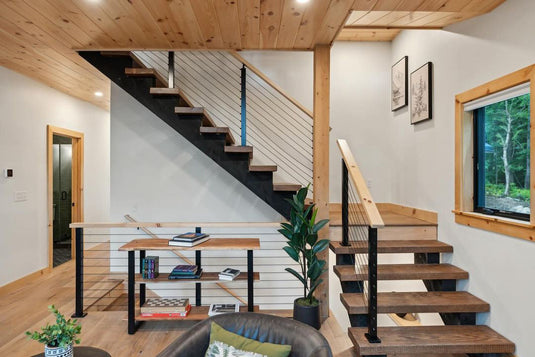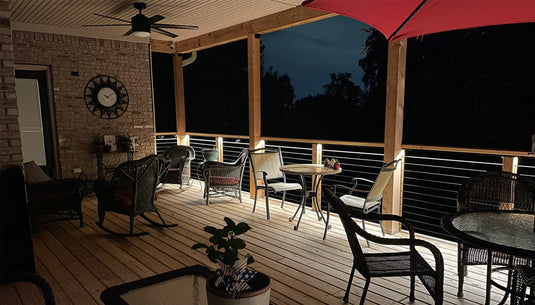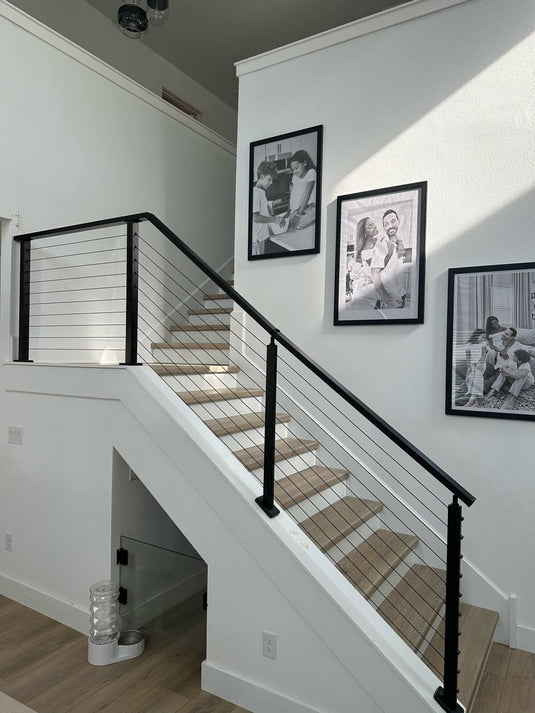TABLE OF CONTENTS
What Is a Stringer For Stairs: Types, Functions, and Construction Guide
Staircases are more than mere pathways between floors; they are architectural statements that marry safety, functionality, and beauty. And at the heart of every staircase is the stringer—a key structural piece that quietly does the heavy lifting. While it’s not always the first thing people notice, the stringer plays a huge role in how sturdy your stairs feel and how good they look.
In this guide, we’ll break down what a stair stringer is, the different types of stinger stairs and construction steps you need to know.
What Is a Stringer for Stairs?
A stair stringer is the inclined structural member—essentially a sloped beam—that supports the treads (the horizontal surfaces you step on) and risers (the vertical components between steps) of a staircase. Think of the stringer as the backbone of the staircase, providing the framework that bears the weight of users and maintains stability.
Stringers serve multiple critical functions:
● Load-Bearing: They distribute the weight of people and objects across the staircase, ensuring it remains sturdy under heavy traffic.
● Structural Stability: By anchoring treads and risers, stringers prevent wobbling or shifting, enhancing safety.
● Shape Definition: The stringer’s angle and layout determine the staircase’s geometry, from steep attic stairs to grand, sweeping designs.


Types of Stringer Stairs
Stringer stairs come in several configurations, each offering unique structural and visual characteristics. The two primary types are dual stringers and mono stringers, with variations based on design and construction.
📌Dual Stringer
Dual stringer stairs feature two parallel stringers running along both sides of the treads and risers, either fully enclosing them (closed stringers) or with cutouts to expose the step edges (open stringers). This design is the most traditional and widely used due to its robustness and versatility.
Closed Dual Stringers
The stringers form a solid, continuous surface along the sides, encasing the treads and risers. This creates a polished, traditional look. Closed stringers are ideal for concealing construction details and providing a clean, finished appearance.


Open Dual Stringers
The stringers are notched or cut to fit the treads and risers, leaving the step edges visible. This design feels lighter and more open, making it a favorite in transitional or modern interiors. Open stringers pair well with decorative treads, like hardwood or glass, to showcase craftsmanship.
Dual stringers offer exceptional stability, making them suitable for high-traffic areas or wide staircases. They can be customized with various materials and finishes to match any decor.
📌Mono Stringer
Mono stringer stairs use a single central stringer, typically a steel or aluminum beam, to support the treads. The treads appear to “float” without visible side supports, creating a minimalist, airy aesthetic. This design is a hallmark of modern architecture, often seen in luxury homes, offices, or galleries.
Key Features: The single stringer reduces visual clutter, emphasizing openness and simplicity. Treads are often thicker to handle loads without side support, and risers may be omitted for a fully open look.

📌Other Variations
Zigzag Stringers Used in unique, sculptural designs, these stringers follow a jagged, sawtooth pattern to support each tread individually. They’re rare but eye-catching in artistic installations.


Curved Stringers Found in spiral or helical staircases, these stringers are bent or molded to create smooth, flowing curves, often in high-end residential or commercial settings.
How to Build a Stringer on Stairs
● Prepare the site
To install a stringer for a floating staircase, often a central steel mono stringer, prepare the site by clearing debris and ensuring the floor and upper landing are clean and level.
● Secure the top plate of the stringer
Position the stringer at the staircase’s center and use a laser level to confirm it’s plumb and aligned with the landing. Clamp it temporarily, mark mounting points on the landing, drill pilot holes and secure the top plate with bolts.
● Secure the base of the stringer and install the treads
Anchor the stringer’s base to the floor with bolts for concrete or screws for wood to maintain plumb alignment. Attach treads to the stringer’s brackets using screws or bolts and ensure they’re level and code-compliant for rise and depth. Apply adhesive for added stability if needed.
● Final Checks
Test the staircase for stability and tighten all fasteners. Verify plumb alignment and code compliance. Clean the stringer and treads and apply finishes or anti-slip strips if desired. Follow the manufacturer’s instructions to preserve the floating aesthetic and consult a professional if structural or code concerns arise.
Conclusion
Stair stringers are the backbone of any staircase, providing essential structural support while shaping its aesthetic and functional design. Through this guide, you must have a deeper understanding of them.
If you’re planning to upgrade or build a staircase, Muzata offers a range of reliable, well-designed stringer systems to fit your needs. Visit Muzata’s website to explore our staircase options and get inspired. The right stringer can make all the difference—let’s build something great together.
FAQs
What materials are commonly used for stair stringers?
Stringers are typically made from wood, steel, or aluminum, depending on the style and structural requirements of the staircase.
Can stair stringers be customized for different designs?
Yes, stringers can be tailored in shape, finish, and material to match various architectural styles, from rustic to ultra-modern.
How do I know if my staircase needs a mono or dual stringer?
The choice depends on the desired aesthetic, load requirements, and available space. Mono stringers suit open, modern designs, while dual stringers offer more traditional support.
Are floating stairs with mono stringers safe?
Absolutely—if engineered correctly. High-quality mono stringers are designed to meet building codes and handle typical residential or commercial loads.
Can I install stair stringers outdoors?
Yes, but you'll need weather-resistant materials like galvanized or powder-coated steel to withstand outdoor conditions.
How do I ensure my staircase complies with local codes?
Consult the local Authority Having Jurisdiction (AHJ) to verify IRC/IBC compliance. Provide engineering stamps or shop drawings for floating stair stringers, especially mono or custom designs.
How much do stringers cost?
Stringer prices vary widely depending on material and design. For a detailed breakdown, check out this cost guide.




